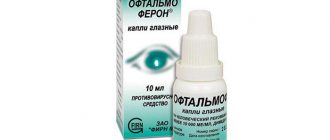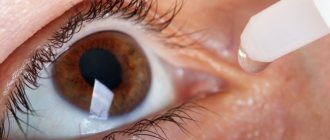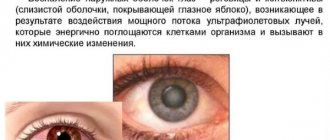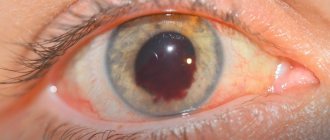In what cases is it necessary to use eye drops?
Eye drops are used for:
- Development of infectious diseases of the visual organs. Ophthalmic solutions can help get rid of infections that develop due to chlamydia, bacteria or viruses. For example, eye drops for blepharitis and stye demonstrate high effectiveness.
- The need to relieve inflammation. Swelling of the eyes may appear against the background of iritis, chorsoiditis, or iridocyclitis.
- Combating allergic manifestations. Eye drops reduce symptoms not only during exacerbation, they are also used for preventive procedures. Allergic reactions are experienced not only by young children, who are more sensitive to foods, but also by teenagers and adults who wear contact lenses for a long time.
- The need to relieve intraocular pressure, which increases with cataracts or glaucoma.
- Relieving pain syndrome. If the disease becomes severe, anesthetics may be required. Also, such compositions are instilled into the eyes after surgery on the visual organs in order to alleviate the patient’s condition after surgery.
- Carrying out diagnostic measures. For this, specialized drops are used that are not sold in regular pharmacies. Such drops allow the doctor to see the fundus of the eye or determine how much tissue has been damaged.
- The need to moisturize the eyes. Such drops are often called “artificial tears.” They are prescribed for certain diseases, prevention of dry eyes, if a person works for many hours every day at the computer or wears contact lenses.
- Improving metabolic processes within the visual organs.
- The need to slow down the development of cataracts or myopia as it progresses.
- Pathologies that lead to vasoconstriction or swelling.
- Mechanical damage to the eyes. Many products accelerate tissue regeneration.
- Other pathologies of the visual organs.
Depending on the type of drops, the dosage is selected by the doctor or the patient determines it himself according to the instructions. Typically, the amount of the drug is calculated so that part of the drug can enter the blood, and the remainder is distributed throughout the mucous membrane of the visual organ.
Even if you drip too much product, the excess will still spill out or come out with a tear.
There are separate, simple and non-potent drops on sale that can be used for severe fatigue, when the eyes turn red and look painful.
Also, with the help of such ophthalmic agents, you can quickly relieve discomfort from burst blood vessels, which also do not look aesthetically pleasing. If there is a feeling of “sand” in the eyes, then you can also use universal soothing drops.
Doctors prescribe eye drops for several reasons:
- Performance. There are many capillaries in the eyeball, through which the drug quickly enters the bloodstream and has a therapeutic effect.
- Efficiency. The liquid form of the drugs has a faster and more powerful effect, especially when the patient suffers from pathologies of the visual organs.
- Delicate impact. Compared to injections, eye drops have a milder effect.
- Small dosage. Just a few drops are enough to get the effect.
Of course, if it is not possible to instill the drug at all, then you can introduce it into the body in other ways, but the effectiveness will be much lower.
Pipette
And first, let's look at what recommendations are followed if you are going to use a pipette in your eyes.
- Disinfect the instrument. The pipette must be sterile. In most cases, the drops are sterile, which means the instrument must match. To do this, place the glass tip or the entire pipette, depending on the material, in a container of water and boil for 5 minutes. This time is usually sufficient.
- Prepare a clean napkin or bandage. You'll need them to blot your eyes. It is also advisable to cover the part of the table or surface on which the drops will be located. It is desirable that the napkin is also sterile, but if this is not possible, it’s okay.
- If you are giving yourself a drop, it is best to sit down and tilt your head back. For another person - in a supine position. However, it is also important to know what kind of drops are used. There are some medications that sting the eyes a little and can cause disorientation for a short time. In simple words, it can make your head spin. In this case, it would be better to lie down.
- Open the medicine, draw up a pipette. As a rule, one press on the rubber tip allows you to draw enough medicine for 3-6 drops.
- Bring the medicine to the eye with one hand and slightly move the lower eyelid with the other. In this case, the eye should look up. Taking into account the fact that the second eye will also automatically look up, it is better that everything is prepared, since you will have to act rather intuitively. Then press the pipette once, preferably not completely, then there will be exactly one drop and it will be easier to calculate the required amount.
- After instilling eye drops, release the eyelid and blot off excess liquid with a napkin. Keep your eyes closed for a while.
- It is very important to remain in a static position for some time. It is best to start moving when your vision clears.
General rules
Instillation of drops into the eyes (the procedure algorithm will be described below) must be performed strictly according to schedule. Otherwise, you can cause infection of a healthy eye. Much attention should be paid to preparatory activities.
It is important to maintain sterility. If you do not follow the instructions, you may not only not cure the visual organs from the disease, but also cause an additional infection.
For the same reason, you should not use drops that have already expired.
Although excess drug does not enter the blood or mucous membranes, you should not use the drug uncontrollably. You need to understand that there are a lot of eye drops on the market with different effects. Only an ophthalmologist can determine the correct drug.
If after the procedure the patient feels a strong burning sensation in the eyes, then it is better to prescribe another remedy. A person may be allergic to the main component of the product.
After instilling the drug into the eyes, it is necessary to reduce the load on the visual organs. This means that for half an hour after the procedure you should not read, watch TV, play computer games or type on a PC.
Common mistakes
Exceeding a single dose of the drug will not bring benefit, but will only lead to its overuse.
The technology of putting drops into the eyes often has some errors that occur due to carelessness or ignorance. Here are the main ones:
- Do not instill more drops than necessary in order to obtain a quick or significant effect.
- When lowering or blinking the eyes frequently during manipulation, the lion's share of the intended dose of the drug flows out and is of no benefit.
- In a standing position, there is a high risk of infection of a larger area of the mucous membrane and skin due to the flow of droplets along with tears.
- Rub the eyeball to better distribute the healing fluid in the eye area. This leads to worsening of the condition and more severe consequences.
- Use cold drops during the procedure.
- Use one device to instill drops into the eyes, nose and ears; for this you need to change special nozzles.
- It is incorrect to store the bottle (in the light) and do not observe the temperature regime. This leads to the fact that the medicinal liquid in it deteriorates and is unsuitable for further use.
If you adhere to the basic rules of use and follow medical instructions, the procedure will go without problems, and the therapeutic effect of the drug will be expressed from the second day of use, but this does not mean that you can stop using the drops in the future or reduce the dosage. Treatment even for the mildest form of illness takes from 5 to 12 days. After a course of manipulations, you must return for a second examination to an ophthalmologist to check the effectiveness of the treatment.
Precautionary measures
The effectiveness and quality of the procedure directly depends on the following precautions:
- You should not use drops that have been stored in violation of the temperature regime.
- Immediately after the instillation procedure, you should not lower your eyes. Otherwise, the drug cannot reach the conjunctival sac and will simply drain. There will be no therapeutic effect in this case.
- Do not put drops into the inner corner of the eye. This will also cause the medication to leak out completely.
- The bottle with the product must be used carefully. Do not touch the eyelashes with the tip or pipette. They contain a large number of microorganisms that can get into the conjunctival sac and beyond. You need to understand that the procedure of instilling drops into the eyes is compared to intravenous administration of the drug. Therefore, the precautions should be identical.
- If a child is being treated, it is important to ensure that after the procedure he does not rub his eyes with his hands.
- Do not touch the pipette or the tip of the bottle to the eye itself. This can lead to injury to the conjunctiva or corneal layer.
- Even if the product causes discomfort, you should not rub your eyes with your hands. A slight, tolerable burning sensation is considered normal for some products. If you rub your eye in such a situation, the discomfort will only intensify. There will also be a risk of inflammation of the mucous membrane of the visual organ.
- If the doctor has prescribed several drugs at once, then you need to wait at least 30 minutes between instillation procedures. This time is enough to ensure that the active ingredients do not mix. This precaution will help prevent side effects.
- An open bottle should be stored in the refrigerator for no more than a month or no longer than the period specified in the instructions.
- You cannot use someone else's medicine or give your own to other people.
- If the product is in a bottle without a special tip, then for each procedure you need to use a new pipette. Under no circumstances should its end be touched with hands or come into contact with any surfaces.
- If the bottle is equipped with a pipette or it comes with it, then you need to keep it in a special case and make sure that germs cannot get on it. After each use of the pipette, it must be rinsed in hot water and dried (without using towels, napkins or other means).
Preparation for the procedure
Instillation of drops into the eyes, the algorithm of which is accessible even to those who are far from medicine, is performed only after careful preparation. You should immediately put a towel, cotton pads (sticks, and a bottle of drops) on a clean table.
Just in case, it’s worth preparing saline solution. It may be needed to wash the optic organ. You also need to prepare your eyes. If a patient is being treated for conjunctivitis, then most likely he suffers from purulent discharge. In such a situation, it is recommended to pre-treat the eye with a cotton pad soaked in saline solution (can be replaced with Furacilin solution).
You need to wipe the visual organ with extreme caution, using wet movements. If you press too hard, you can damage thin and sensitive skin.
Before the procedure, you need to wash your face well. It should not contain any cosmetic product. If the components included in cosmetics enter into a chemical reaction with the medicine, then it is difficult to predict the consequences. Therefore, it is better not to take risks.
You should not use cosmetics (including various moisturizers) even after using drops, and preferably until complete recovery.
How to put drops in children's eyes?
It is better for a child to do this procedure while lying down.
Carrying out the procedure for a child is much more difficult than for an adult, since he will be afraid, because of this he may twitch and, at best, spill the dropper bottle, and at worst, damage his eyelid, conjunctiva, or mucous membrane. Therefore, before starting the manipulation, the baby needs to be distracted or interested in a bright toy hanging from the playpen or a pattern on the wallpaper, ceiling, or in the room. If it is difficult to put drops into the eyes of children, you can ask your loved ones to hold the child in their arms in a reclining state; a chair is perfect for this. After the manipulation, stay in this state for 5-10 minutes, and then you can let the baby go. The technique of putting drops into a child’s eyes consists of the following steps:
- Using a cotton pad, rinse children's eyes with warm boiled water, “Sodium chloride” or a weak solution of “Furacilin”.
- Allow the child to rest for 10 minutes.
- Heat the solution until warm.
- Place the child in a horizontal position and rest your elbows on both sides of his body.
- Pull back the lower eyelid and place a few drops into the conjunctival sac.
- Ask to move your eyes while closed.
- Blot excess solution with a dry cloth to prevent the solution from getting into the ear.
- The baby needs to lie down for 5-10 minutes.
Friction of the organs of vision immediately after instillation of the drug is fraught with the introduction of an infectious agent into them.
Even if it was not possible to drop drops into the corner of the eye, the medicine still got onto the mucous membrane, and thanks to the rotational movements it was distributed throughout the entire eyeball. After the eyes have been put in drops, under no circumstances should the child be allowed to rub or touch them with his hands, to avoid infection.
Hand hygiene
An important stage of preparation is hand hygiene. They must be washed thoroughly with bactericidal soap. Do not let areas of skin pass between your fingers. Additionally, you should use a brush to clean out dirt under your nails.
Also, no particles of the soap itself should remain under them or on the skin. It can cause additional eye irritation if it gets into them. This will cause particular discomfort to the child.
It is better to dry your hands simply in the air. If you use a towel, invisible pieces of fabric may remain on your hands. Another person could have used the towel and left bacteria on it.
After washing your hands, you should not touch anything. You need to start the procedure immediately, contacting only the bottle of the product.
The sequence of putting drops into the eyes
Often you have to perform the procedure yourself.
In this case, the algorithm of actions is as follows:
- First of all, you need to carry out all hygiene measures.
- After this, you need to take a comfortable position (for example, sitting or lying down) and tilt your head back.
- The next step requires pulling the lower eyelid down. The eye at this moment should look upward. Only in this position of the eye does the conjunctival sac open as required.
- Next, you need to instill a few drops of the medicine (or as much as indicated in the instructions or doctor’s prescription).
- Wait a few minutes and close your eye.
- Clean the pipette and put the bottle in the refrigerator.
A similar procedure is performed when using most ophthalmic agents in the treatment of various diseases.
| Pathology treated with drops | Effective drug | Peculiarities |
| Conjunctivitis (bacterial) | Levomitecin | A broad-spectrum drug. The product is not able to penetrate the lens. The drug quickly relieves discomfort and is suitable for long-term use. |
| Conjunctivitis (viral) | Oftalmoferon | Well relieves inflammation caused by a virus or allergen. The drug is a mild anesthetic. Promotes rapid tissue regeneration. |
| Glaucoma | Timolol | It is a beta-blocker, which, due to the active substance, can reduce the amount of aqueous humor. Usually doctors recommend instilling no more than 1 drop twice a day and not exceeding the duration of the course of treatment. |
| Barley | Gentamicin | The main component is the antibiotic – gentamicin sulfate. The product is used for severe inflammation and risk of damage to the ocular structure. Directional agent. |
If the medicine is used by a patient who wears lenses and wants to additionally moisturize the eyes, then there are special products that can be dripped directly onto vision correctors. For example, such drugs include Cationorm, Okutiarz, Oftagel.
Technique for instilling drops into the ear:
1. Before using, warm up the drops by lowering the bottle of medicine into a bowl of hot water for a few minutes. Check the temperature of the drops by placing a drop of medicine on the back of your hand.
2. Clean the external auditory canal with a cotton swab.
3. Lay the child on his side with the affected ear facing up.
4. With your right hand, draw drops into the pipette, and with two fingers of your left hand, grab the upper part of the auricle and pull it perpendicular to the head and slightly down.
5. Place as many drops of medicine into the child’s external auditory canal as prescribed by the doctor.
6. Cover the external auditory canal with clean cotton wool (but make sure that the ball of cotton does not penetrate deep into the ear canal).
Instructions for children
Putting drops into the eyes of children requires a clear algorithm of actions. In this case, you may encounter some difficulties. Even an adult does not like it when something gets in his eyes, and a child may even react too impulsively.
Therefore, you must first calm the patient down and then carefully proceed with the procedure:
- First you need to thoroughly wash your hands and prepare everything you need.
- If a child has purulent discharge and crusts in or around his eyes, they should be carefully cleaned with a cotton swab and saline solution.
- Hold the bottle with drops in your hands for a while so that the medicine warms up a little.
- Place the child in a chair or lay him down on the bed with his head tilted back. If the child is nervous, then you need to give him time to calm down and only then begin the procedure. It may not be possible to apply drops the first time, as the child may close his eye, start twitching, or stop looking up. It can also lead to parents accidentally scratching their eye.
- When the child calms down, you also need to pull back the lower eyelid and instill the drug.
- After this, you need to ask him to lie still for a while. At this time, you can blot off excess medication using a lint-free cloth swab.
If tampons, napkins or cotton pads are used, you need to remember that they cannot be used for both eyes. Each visual organ needs a new, clean napkin.
If during the procedure the child still closes his eyes and nothing gets into the conjunctival sac at all, then you need to repeat the algorithm of actions again, starting with washing your hands. But, if at least part of the product gets into the eye, then the manipulations cannot be repeated. This can provoke an overdose of the drug and a subsequent reaction.
In order for the treatment of infectious conjunctivitis to be most effective, you need to provide the child with a personal towel and change it at least once a day. It is recommended to change the pillowcases on your pillows daily. It is advisable to iron washed bed linen. If your child wears glasses, they also need to be cleaned daily.
Technique for instilling drops into the nose:
It is more convenient for small children to instill drops together with an assistant. An assistant can hold the child in his arms in a semi-sitting position. For older children, nasal drops can be administered while lying down or sitting with the head thrown back.
1. Before administering the drops, clear the child’s nose of mucus and crusts: for babies, use a cotton wick, and for older children, blow their nose, freeing the right and left nasal passages in turn. Remember that a separate wick is used for each nasal passage and both nostrils cannot be cleaned at the same time. For infants, you can clean the nasal passages using a small syringe, sucking out the mucus.
2. Pipette the medicine.
3. Holding with your hands, slightly lift the tip of the child’s nose. Tilt your head to the side: when instilling the right half of your nose, move to the left, and vice versa.
4. Trying not to touch the nasal mucosa with the pipette, inject 2-3 drops of the medicine.
5. Leave the child's head in the same position for 30-60 seconds to evenly distribute the medicine throughout the mucous membrane.
6. In the same sequence, introduce the drops into the other nasal passage.
For baby
Putting drops into the eyes (the algorithm is the same for almost all formulations) is slightly different for a baby.
The sequence of actions is as follows:
- First you need to wash your hands. If there are concerns, you can purchase special medical gloves and instill drops in them.
- After this, you need to swaddle the baby and place it on a bed, table or sofa in a horizontal position. You should first make sure that your child does not need to change his diaper. Otherwise he will be nervous. If the child cries, the drops will not have any effect and will simply flow out with tears. Therefore, first you need to calm the baby. You can give him a pacifier or a bottle of milk.
- After this, it is necessary to clean the child’s eye with saline solution.
- The next step requires using your thumb to very carefully pull back the child’s lower eyelid slightly so that the conjunctival sac opens. There is no need to pull hard.
- After this, you need to drip the product and release the eyelid.
- When the baby closes his eyes, you need to blot the eyelid a little with a cotton pad and remove the excess product.
- If required, the procedure must be performed for the second eye. If only one is being treated, then it is advisable to also wipe the healthy eye with saline so that it does not get infected.
- After completing the procedure, it is necessary to tightly close the bottle, rinse the pipette and put the drug in a cool place.
Before each procedure, it is worth checking the expiration date of the medicine, as it is easy to forget exactly when the medicine was purchased. After the first instillation, you need to monitor the child for several hours. It is very difficult to determine in advance whether a child has an individual intolerance to the drug.
For the same reason, it is recommended to perform the first instillation with a smaller dose of the medicine. If the patient's eye or face begins to swell, he should immediately contact an ambulance.
How to administer drops to an adult?
It is advisable that someone help an adult in this matter.
It is best if another person helps you carry out the procedure, since it is not always possible to apply eye drops to yourself correctly. It is possible that the mucous membrane of the eye may be touched with even greater damage, eye drops may get into the nose, or incorrect calculation of the amount of drug released from the bottle. But if you still have to do the procedure yourself, there is a certain sequence on how to properly apply eye drops to an adult:
- With one hand, pull down the lower eyelid, with the other, drip drops into the area of the conjunctival sac.
- Close the eye and make several rotational movements with the pupil to better distribute the medicine over the outer and inner mucous membrane.
- Do the same with the second eye.
- Blot excess liquid over the closed eyelid with a dry cloth.
- Stay in this position for a short time - 10-15 minutes.
To avoid side effects, administering two drugs simultaneously is strictly prohibited. The break between them should be at least 30 minutes.
If the baby resists
If a child reacts very sharply to instillation, then under no circumstances should you frighten him. For example, some parents begin to talk about how the big and scary doctor will come and drop the drops himself. This upsets the child even more; he can easily start crying, and then the procedure will definitely have to be postponed.
Psychologists have also proven that such methods, although sometimes effective, can have a strong impact on the psyche of a child, who, even as an adult, will be afraid of doctors, associating them with scary uncles.
First, you should try to explain to the child that although the procedure is not pleasant, it will relieve him of discomfort. It’s better to wait a few seconds, but then your eyes will see better and the inflammation will subside.
But this method can work with children from 3 years old. Younger patients will not understand such explanations. In this case, you can distract the child, for example, by starting to tell him a fairy tale or getting him interested in an exciting game.
If the child is restless and does not want to open his eyes and look up, then you can ask the other parent to hold the toy and invite the patient to watch it. In this case, practice will be required, since instillation must be carried out very quickly, but carefully.
You can come up with your own game, during which one of the parents will hold the child. But the game must be fun. Or you can come up with a game in which the child plays a superhero who receives powers after instilling special drops. The main thing is that he understands that this is just fun and does not try to give himself additional powers on his own.
Gradually, the child will understand that such procedures cannot harm him. But you need to be patient during the first instillations. If the first instillation is associated only with fear, then all subsequent manipulations will be extremely difficult to perform.
Common Mistakes
Instilling drops into the eyes (the algorithm is the same for adults and children) requires following the instructions. However, it is not always possible to avoid side effects.
Algorithm for instilling drops into the eyes
To eliminate the possibility of problems, you need to pay attention to the following:
- You should not prescribe drops for yourself or your child. There are quite strong antibiotics and products on sale that are not intended for certain categories of patients.
- You should not instill drops if your eyes are very watery.
- Even if it seems that the drug is not having the desired effect, you should not instill it twice at once.
- If you do not remove purulent discharge from the eye before starting the procedure, this will lead to the fact that the substance will not be able to reach the desired area of the conjunctival sac. All treatment may be nullified.
- You should not use medicine that was sold in a damaged, slightly opened or cracked bottle. It is not known how long the drug was stored in this condition. In addition, pathogenic microorganisms could begin to accumulate in it.
- The course of treatment cannot be increased. For example, antibiotic-based products can be instilled for no more than 7 days. After this, bacteria can develop so-called drug resistance.
- After instillation, you cannot blink for a few seconds, even if you really want to. This will lead to complete rinsing of the product before it penetrates.
- Do not instill drops directly onto the cornea of the eye. This can lead to severe burning and pain.
If you follow all the above rules, then putting drops into your eyes will not cause complications, and over time, both the burning sensation and discomfort will disappear after performing such procedures. Although the algorithm for administering the drug using this method is extremely clear, you should once again consult with your doctor and carefully study the instructions for the drug prescribed by the ophthalmologist.
Features of instilling eye drops in children
There are no fundamental differences between instilling drops in adults and children. But if a child, seeing you with a bottle of drops in his hands, does not allow you to get closer and closes his eyes tightly, let him leave his eyes closed and lie on his back. Place 1-2 drops into the inner corner of the eye. When the child opens his eyes, the drops will fall where they should.
It is often better to treat young children while they are asleep - it is easier and less traumatic than trying to hold the eyelids while the child struggles.
Eye drops for children: permitted age, dosage, links to instructions










